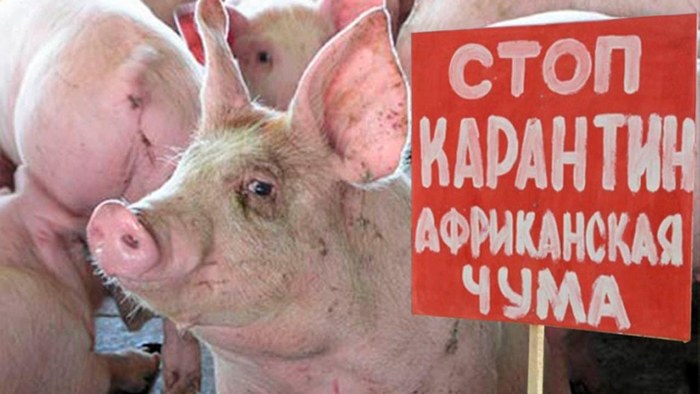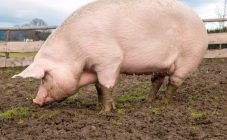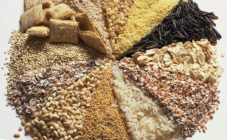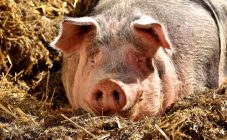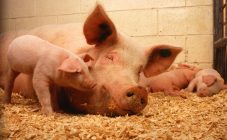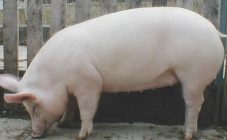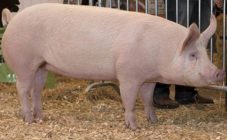In the process of keeping any farm birds and animals, if the rules of sanitary and hygienic processing of premises and storage of feed are not followed, the livestock may begin to suffer from various diseases. The severity of the course is determined by the rate of differentiation of the pathogen and competently carried out treatment.
Description of the disease
Classical swine fever (CSF) is a highly contagious infectious disease. It affects the cardiovascular system, disrupts the processes of hematopoiesis, causes inflammation of the large intestine and lungs, and is accompanied by a febrile state. Compared to all other diseases, plague is the undisputed leader in causing damage to livestock.
The plague is caused by a virus belonging to the togavirus family, which has RNA molecules as genetic material with a cubic structure. When viral particles enter the animal's body, they accumulate in the lymphatic system, bone marrow, and also in the liver. Thinning of the vessel walls occurs, which causes hemorrhages and tissue inflammation, accompanied by the formation of necrosis.
Despite the severity of the disease in animals, it does not pose a danger to humans. This virus is a species specific and infects only pigs of any breed, for example, Vietnamese. In the early 2000s, outbreaks of plague epidemics were noted in the Ryazan and Tver regions.
There is a disease similar in primary symptoms - African swine fever. Just like CSF, it is not dangerous for other animal species. Therefore, to the question "Do goats get African swine fever?" it is safe to give a negative answer.
In addition to a herd of domestic pigs, wild boar breeds are susceptible to the disease. There is no age differentiation; an individual at any age can be infected with a virus.
Several possible routes of transmission of the disease have been recorded. Most often, transmission occurs through the waste products of animals from a sick to a healthy individual. By the penetration of viral particles into the body, infected food and water more often become. In addition, you can get infection through damaged skin and airborne droplets.
Other routes of distribution may include:
- Storage of products obtained from the slaughter of infected individuals;
- Transporting pigs in the same carrier that previously transported infected individuals;
- Transfer of the pathogen to other animals. Despite selectively infecting only pigs, many animals can carry viral particles. This can be a dog, cat, rodents, and even earthworms. A live rat entering a pig stall may spread the infection.
To prevent the death of the entire livestock, it is important to notice the characteristic symptoms in the early stages. There is currently no effective vaccine to cure. However, the timely isolation of infectious animals will help keep the rest of the herd from dying.
Isolation of a sick pig
Pig distemper differentiates into several forms of the disease:
- hyperacute;
- sharp;
- subacute;
- chronic;
- atypical.
Each of the forms of swine fever has its own symptoms.
The course of the hyperacute form ends in death a few days later.This form affects young piglets and is accompanied by vomiting, the appearance of bright red spots on the skin, and a peak temperature increase. On the third day of distemper, piglets show unsteadiness of gait and general weakness of animals. These symptoms are similar to African swine fever. If a pregnant sow is infected, there is a high risk of miscarriage.
Death in the acute form occurs 7 days after the first symptoms appear. Usually, death is preceded by the animals falling into a coma. At first, the temperature rises. Disruption of bowel movements ranges from constipation to diarrhea. At the same time, blood clots are often present in the feces. The mucous membranes of the eyes and nose suffer from suppuration. Yellow pustules develop in the abdomen, thighs and ears. Thinning of blood vessels leads to the appearance of punctate hemorrhages.
The course of the subacute form takes on average 3 weeks. At this time, a sharp weight loss of the individual is noted. The appearance of purulent expressions in the eyes and nose. A cough develops. Defecation is characterized by a strong specific odor.
There are cases when the subacute form becomes chronic. Manifestations of a febrile condition, cough and other symptoms occur periodically. The characteristics of the form are as follows:
- anorexic state;
- temperature rise;
- acute conjunctivitis;
- decreased appetite.
Lack of treatment can lead to complications:
- Bacteriological infection with salmonella against the background of the clinical picture of plague. At this time, diarrhea with blood and purulent discharge is noted. The lack of normal bowel function leads to a decrease in body weight;
- Infection with paterellosis leads to the development of severe cough, hemorrhages in the oral cavity and fever;
- Mixed contamination leads to exaggerated symptoms leading to the death of the animal.
Treatment
An effective treatment for classical swine fever has not yet been developed. In 1990, V.I. Chemarantsev et al. In the abstract, the manifestation of positive dynamics when using a complex drug that has anti-inflammatory and antibacterial effects (Anti-CSF). However, the drug has not received full recognition.
You cannot leave infected pigs to live with healthy ones. Affected gilts should be isolated from the general herd in the traditional way and slaughtered by carefully disposing of the infected carcasses. In this case, it is necessary to use replacement clothes, since a person can act as a carrier of the plague disease.
In the course of laboratory research, it was revealed that the activity of the virus persists for 11 days at a temperature of 11 ℃. If this temperature is maintained, the inactivation of the virus occurs after 18-20 days. When the temperature rises to 45-56.5 ℃, decontamination occurs within 2 days, and when heated to 78 ℃ - in 1 hour.
If a virus is detected in urine, heating to 65 ℃ kills it after an hour. Studies have shown that the virus is highly sensitive to chloroform, ethers and deoxycholate.
Individuals who survived the epidemic develop a stable immunity that persists throughout their lives. Currently, in order to prevent massive infection of herds, measures are being taken to introduce vaccinations. Dried preparations of cultural (vaccine KS and LK) and lapinized virus vaccines are widely used. The lapinized CSF vaccine of pigs is administered according to the instructions at the rate of 2 ml for piglets aged 50 and 75 days. The use of vaccines allows pigs to develop immunity in 4-7 days after administration.
Preventive measures
The construction of closed-type farms with equipped veterinary sanitary passes and disinfection barriers prevents the introduction of the pathogen.When acquiring new individuals, it is necessary to withstand quarantine for 30 days before admitting an individual to the main herd.
Regular disinfection is also needed for animal transport devices. Food waste used for feed must be disinfected at high temperatures.
If the disease spreads across the farm, the area must be quarantined. At this time, restrictions are imposed on the import and export of animals to the territory; it is impossible to slaughter without the permission of the veterinary service.
After forced slaughter, the skins of pigs must be scalded and scorched, and the corpses must be burned. The remaining uninfected individuals need to be vaccinated urgently.
The manure remaining after the destruction of individuals should be treated biothermally. Permission to lift quarantine can be obtained after 40 days after the last death, subject to the observance of regulated sanitary and hygienic measures in relation to the premises and objects in contact with animals.
In conclusion, we can say that infection with classical swine fever can lead to global losses of livestock. Unfortunately, there is no current treatment regimen. Infected individuals must be isolated and the previous room must be carefully treated with disinfectants.
It is imperative to protect the farm from entering the territory of animal carriers (these are cats, dogs, rodents, wild animals). Food supply and drinking water must undergo decontamination procedures. Deratization measures will help reduce the likelihood of infection, both of the animals themselves and of feed, with the waste products of rats.
In case of infection, you should immediately quarantine the farm. After 40 days after the last death of livestock, the restrictive regime can be lifted.
The detection of any sign characteristic of plague is a reason to contact the appropriate veterinary services. Compliance with regulated standards of keeping and regular examinations of pigs will help to avoid the occurrence of such a disease.
